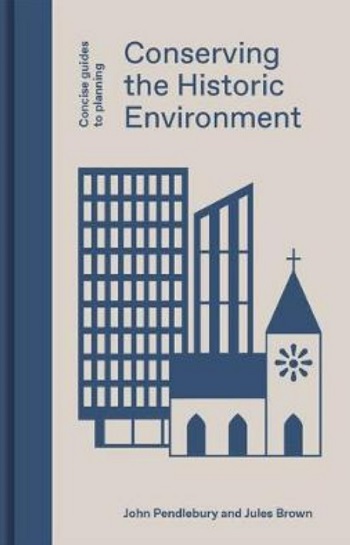Conserving the Historic Environment
Conserving the Historic Environment, John Pendlebury and Jules Brown, Lund Humphries, 2021, 160 pages, 48 black-and-white photographs and illustrations.
Conserving the Historic Environment is one of a series of 13 Concise Guides to Planning, including other such related specialist areas as The Urban Design Process, Green Infrastructure and Healthy Cities. Despite the use of the term ‘concise’ in the series strapline and the pocket-size (A5) of the printed book, this volume packs a vast amount of relevant and mostly objective information about many aspects of the topic. Its limited size and relatively broad target audience prevent it from providing the full chapter and verse on heritage-related issues, in the way that Charles Mynors’ Listed Buildings, Conservation Areas and Monuments does on conservation law. Even so, it certainly provides a more-than-decent introduction to philosophy, policy and practice in the profession of conserving the historic environment, in a well-structured and logical sequence.
To compensate for the selective detail, the book helpfully suggests further reading on each chapter. To enable a rapid read for those with limited time or timespan of attention, each chapter has a concise summary. The book would therefore be a valuable starting reference for non-specialist planners, other related professions, students and any member of the public who might be trying to grasp an understanding of decision-making, or indeed to influence the (sometimes seemingly illogical) decisions and recommendations made by heritage professionals.
The equitable balance in the book between theory and practice is achieved by the complementary backgrounds of the two authors. John Pendlebury is an experienced academic who has also worked as a local authority conservation officer. Jules Brown is an experienced conservation practitioner, who has also lectured on the management of the historic environment. It is unclear who wrote each chapter, but they have a consistency of approach and style. The language throughout is clear and legible, avoiding excessive jargon. Reassuringly, the authors are both members of the IHBC, although this is not clear from the book itself and, somewhat disappointingly, the IHBC gets only a brief mention in the introduction – as the relevant professional body, despite its crucial role in maintaining standards and its growing influence in policymaking.
The practicality and usefulness of the book is assisted by the inclusion of critical illustrated case studies, albeit they can only scratch the surface of the vast complexity of situations that are faced in day-to-day heritage management. The book concentrates on conservation in England, but it is set in the context of conservation as an international activity, with references to Unesco and ICOMOS charters and international case studies.
It touches on the concept of the historic urban landscape and contemporary human values, including the impact of Black Lives Matter on attitudes to the monuments to the great and the (not so) good. It includes the fascinating case study of the Hall of Clestrain on Orkney, which well illustrates the frequent philosophical dilemma of deciding what era an evolved and altered historic building should be restored to (if at all). The stock answer to the dilemma is of course that all decisions should be based on an understanding of the significance of a building, although this does not always result in a consensual decision.
The book addresses the philosophy of the crucial issue of managing change. It summarises the SPAB approach and states: ‘SPAB principles still have salience, but much practice has deviated from strict implementation’. It recognises that heritage practitioners have competing pressures: balancing the objectives of strict conservation principles with the wider objective of facilitating a viable adaptive re-use of an individual historic building, which can help both to sustain it into the future and contribute to broader urban regeneration.
The optimistic foreword says the book aims to help us ‘to consider how best to preserve sensitively the best of the past, in ways that allow us to continue to build and improve attractive areas’. It is a starting point towards that laudable objective.
This article originally appeared as ‘Competing pressures’ in the Institute of Historic Building Conservation’s (IHBC’s) Context 173, published in September 2022. It was written by John Hinchliffe, Hinchliffe Heritage.
--Institute of Historic Building Conservation
[edit] Related articles on Designing Buildings
IHBC NewsBlog
Purcell’s guidance on RAAC for Listed Buildings in England & Wales
The guidance specifically focuses on Reinforced Autoclaved Aerated Concrete (RAAC) in listed buildings.
IHBC Membership Journal Context - Latest Issue on 'Hadrian's Wall' Published
The issue includes takes on the wall 'end-to-end' including 'the man who saved it'.
Heritage Building Retrofit Toolkit developed by City of London and Purcell
The toolkit is designed to provide clear and actionable guidance for owners, occupiers and caretakers of historic and listed buildings.
70 countries sign Declaration de Chaillot at Buildings & Climate Global Forum
The declaration is a foundational document enabling progress towards a ‘rapid, fair, and effective transition of the buildings sector’
Bookings open for IHBC Annual School 12-15 June 2024
Theme: Place and Building Care - Finance, Policy and People in Conservation Practice
Rare Sliding Canal Bridge in the UK gets a Major Update
A moveable rail bridge over the Stainforth and Keadby Canal in the Midlands in England has been completely overhauled.
'Restoration and Renewal: Developing the strategic case' Published
The House of Commons Library has published the research briefing, outlining the different options for the Palace of Westminster.
Brum’s Broad Street skyscraper plans approved with unusual rule for residents
A report by a council officer says that the development would provide for a mix of accommodation in a ‘high quality, secure environment...
English Housing Survey 2022 to 2023
Initial findings from the English Housing Survey 2022 to 2023 have been published.
Audit Wales research report: Sustainable development?
A new report from Audit Wales examines how Welsh Councils are supporting repurposing and regeneration of vacant properties and brownfield sites.

















